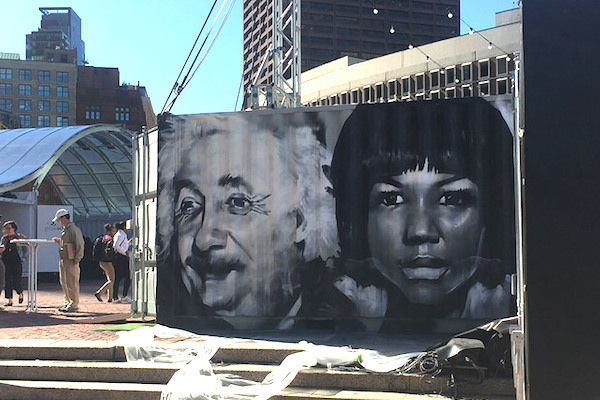Faces and Gene Blending
- alberta8
- Jul 7, 2015
- 4 min read
Updated: May 30, 2020

Contributed by Rebecca Ruehlman
Globalization is bringing once-distant ancestries closer together. Tiger Woods has described himself as racially 'Cablinasian' a mix of Thai, Chinese, Native American, Caucasian, African American, Indian and Asian descent. Louis C.K. is from Hungarian, Mexican and Irish descent. Jessica Alba is a mix of Mexican on her father’s side and a combination of Welsh, German, Danish, French Canadian, and English on her mother’s side. Aubrey Plaza is from English, Irish and Puerto Rican descent. Today, with increased global travel and immigration combined with a decrease in ethnicity guiding partner selection, we are seeing heritages blending. Will the blending of heritages bring greater or fewer differences in facial feature combinations? Currently, there is an ongoing debate between those who believe that new and uncommon combinations in human facial features will be prevalent, while others believe certain recessive genes will die out and faces will blend and look dramatically similar. What does the future hold for facial features and how can Facetopo’s research illuminate the conversation?
In Live Science's “Life’s Little Mysteries,” Dr. Stephen Stearns, Ph.D., Yale University Professor of Ecology and Evolutionary Biology articulates, "In a few centuries the human race will all look like Brazilians, a mix of facial features from around the globe." Stearns says globalization, immigration, cultural diffusion and the ease of modern travel will gradually homogenize the human population, averaging out more and more people’s traits. Stearns continues, "because recessive traits depend on two copies of the same gene pairing up in order to get expressed, these traits will express themselves more rarely, and dominant traits will become the norm."
However, not everyone is sold on Stearns’ theory. Razib Khan, a graduate student in Integrative Genetics & Genomics Graduate Group at University of California at Davis argues, "Rather than less diversity, there is the potential for more diversity in facial features." In an article for The Unz Review Khan states, “Genetics is not a blending process, it is a discrete one, which reconfigures variation every generation.” Khan continues with his argument stating, “Though the phenotypes, the traits, may exhibit blending between parents, the underlying genetic variation is governed by Mendelian dynamics.”
Take eye color for example: in the United States, blue eye color, a recessive trait, has grown far less common over the last century. A 2002 study by the epidemiologists Mark Grant and Diane Lauderdale found that only 1 in 6 non-Hispanic white Americans has blue eyes, down from more than half of the U.S. white population being blue-eyed just 100 years ago.
In The Tech a publication of the Tech Museum of Innovation in San Jose, CA, Dr. Barry Starr, Ph.D., geneticist and professor, thoughtfully answers museum visitor and student questions about genetics. Dr. Starr explains to a visitor in 2010: the fact is blue eyes are indeed becoming rarer to find. While eye color is a polygenic trait (determined by multiple genes) blue eye color is follows the inheritance pattern of a recessive trait. One of the reasons for this decrease in blue-eyed U.S. residents is immigration, which is increasing all over the world. Another reason is that today, people are using ethnicity less often as a way to choose a partner. As these two trends: more brown-eyed people and more mixed-eye-color marriages will continue into the future, blue-eyes will become rarer but they won’t disappear. For an excellent explanation of the genetics of blue eyes, read the complete article in The Tech. In answer to a Nevada student’s 2014 question asking if redheads will go extinct, Dr. Starr responds that while redheads will be harder to find, they will not be going extinct.
Easily quantified, hair color and eye color are good starting examples. However, Facetopo is interested in quantifying other genetically-determined facial phenotypes that are a bit more complicated to measure such as face shape, nose height, and other aspects of facial morphology. Who doesn’t love getting in the middle of a juicy scientific debate? 3-D facemaps contributed by Facetopo community members will provide data for Facetopo research in the areas of quantifying a varied and wide sampling of facial features. At Facetopo we are driven by our curiosity about what can be learned from diverse faces and facial features. Of course at the moment, we don’t know what our findings will be, we are just taking the first steps in this new citizen science research endeavor: gathering the most accurate data possible. To that end, we are developing the Facetopo App to help users accurately measures their faces in 3-D.
The Facetopo App, releasing in Fall 2015, will enable community members to map a number of scientifically-defined facial landmarks onto photos, essentially translating faces into 3-D coordinates. This data is pooled with other data as we analyze a large global population of face data looking for similarities, differences, and patterns in the information. Facetopo performs data analysis that statistically creates groups of similar and contrasting facial measurements within a very large population dataset. We plan to use survey responses to see how things like ethnography relate to your facial features. It’s possible that Facetopo data may support scientific findings that eventually connect with personalized medicine, genomics, behavioral health, population genetics, and ethnography. If you’d like to help scientists learn more about faces and support scientific research in the area of facial morphology sign up to Beta test the Facetopo App and you’ll be notified upon project launch.
Top of Page Photos L-R: Tiger Woods, Amy Adams
REFERENCES
Tiger Woods is Cablinasion: http://www.theguardian.com/sport/2010/may/29/tiger-woods-racial-politics
“What Will Future Humans Look LIke?” by Natalie Wolchover. Live Science. http://www.livescience.com/34228-will-humans-eventually-all-look-like-brazilians.html
People in the Future Will Not Look Like Brazilians by Razib Khan. The Unz Review. http://www.unz.com/gnxp/people-in-the-future-will-not-look-like-brazilians/
“Eye Color” by Barry Starr. The Tech (Tech Museum of Innovation, San Jose, CA): http://genetics.thetech.org/ask/ask355
“Cohort effects in a genetically determined trait: eye colour among US whites” Authors: M. D. Grant, and D. S. Lauderdale. Annals of Human Biology. 2002, Vol. 29, No. 6 , Pages 657-666 http://informahealthcare.com/doi/abs/10.1080/03014460210157394
“Redheads Not Doomed” by Barry Starr. The Tech (Tech Museum of Innovation, San Jose, CA): http://genetics.thetech.org/ask-a-geneticist/redheads-not-doomed-extinction




Comments